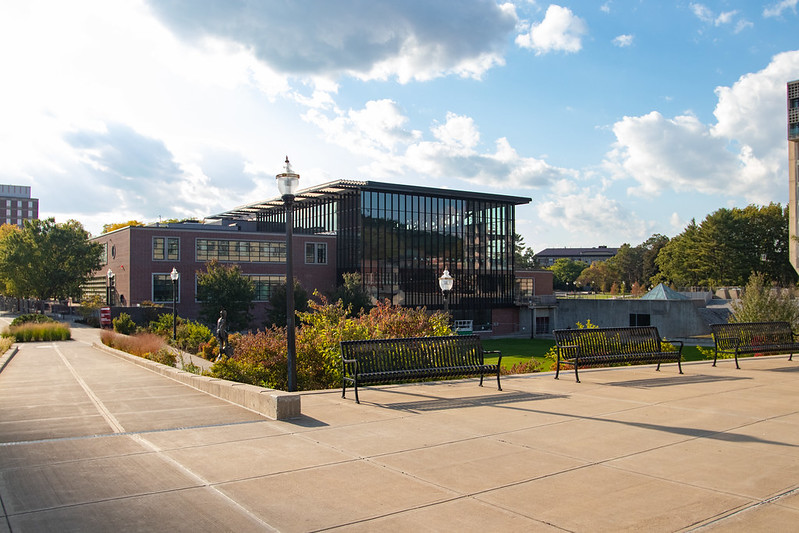 A person’s ability to recognize and differentiate between human faces may be developed as early as six to nine months in age, according to a study conducted by a University of Massachusetts psychologist.
A person’s ability to recognize and differentiate between human faces may be developed as early as six to nine months in age, according to a study conducted by a University of Massachusetts psychologist.
“I don’t think people realize how important face processing is,” said Lisa Scott, who heads a research team at UMass’ Brain, Cognition and Development Laboratory in Tobin Hall. “It’s the most important social cue we use to recognize and identify people. We universally have this expert ability to recognize faces and it has a lot of consequences with social interactions.”
Scott’s team’s most recent findings will be published in the Journal of Cognitive Neuroscience in October.
At the heart of Scott’s research is the theory of perceptual narrowing. According to Scott, 6-month-old infants actually have a better ability to distinguish unfamiliar faces than those at nine months of age. During this three-month period, the infant focuses on faces in his or her environment. The broad ability the infant possessed at six months of age is narrowed at nine months to mainly include only faces encountered regularly during that time, Scott noted.
Infants also possess this ability when recognizing non-human animals and objects as well, she said. Based on parents’ interactions with their infant children, babies will learn to either differentiate between different objects or categorize them. For instance, Scott said, if a parent identifies dogs in the neighborhood by the animals’ individual names, the child will learn that it is important to visually learn the difference between dogs. The infant exposed to individual names will be more likely to distinguish one dog’s face from another, she said.
But an infant whose parent identifies every dog as “dog,” “doggy” or “puppy” will not learn that it is important to distinguish between different dogs. And for animals that a baby never sees, such as monkeys, this phenomenon is even stronger, said Scott.
The lab tested this by showing 38 infants images of strollers. During a three-month period, one group of babies was taught to identify strollers on an individual level, while the other group learned to categorize strollers as a whole.
Using video cameras to examine eye movement, and electrodes to test brain activity, Scott observed 6-month-old infants looking intently at images of strollers. An image of a stroller was shown for a long period before a new image of a stroller appeared. The infants’ attention changed to the second image and they focused longer on the new one than the old one. This suggested to Scott that the 6-month-old babies were recognizing the differences between the two stroller images.
During the three months that followed, parents read picture books to their infants. One set of babies had picture books that labeled each image as “stroller.” The other group, however, had picture books that identified each stroller individually with made-up words. The picture books were read with a schedule that tapered down as the three months went on, said Scott.
When the babies returned to the lab at nine months of age, the process was repeated. Those who had read the picture book with made-up words exhibited more interest in a new image of a stroller than an old one, showing Scott that the babies had learned the importance of identifying the difference between various strollers. This group increased its ability to differentiate between the strollers by 13.7 percent, from 51 percent at six months of age to 64.7 percent at nine months of age, a press release about the study states.
But the second group – the babies that had seen every image of the stroller with the generic label “stroller” – saw no improvement in being able to discern between the images, said Scott. The press release stated that this group could differentiate the strollers 48 percent of the time, both at six months and nine months of age.
“All in all, it seemed to us that if we labeled objects at the individual level, babies started to treat those objects more like faces,” she said. “[As infants] we learn to identify … and tell the difference between individuals. Whereas with objects, it’s not very important for us to do it, so we don’t usually do it.”
Scott’s next study will continue the exploration of face recognition. On Aug. 1, she received a $675,000 grant from the National Science Foundation to begin the project in the lab.
“The new work will try and understand how babies learn about some kinds of faces as opposed to other kinds of faces,” she said. “We think that labeling, because it’s important with these objects, [is] also important with faces. If babies aren’t getting a lot of experience with faces that aren’t familiar to them like faces of another race, it could be building a bias in the system to not tell a difference between those faces as clearly as they could tell the difference between faces that they have a lot of experience with.”
The process for this new study will be relatively the same as the previous one, with infants being tested at six and nine months of age. In between, their parents will read them picture books, this time with images of human faces from different races.
One group of babies will see the images labeled with one consistent generic label of “Other.” The second group will see the images with individual names from other cultures.
Scott is looking forward to seeing the results of this study and learning if racial biases are partly formed during this period of time in an infant’s development.
“Recognizing people of other races is a really important thing to do,” she said, noting that some areas of the United States are very diverse, while others are not, which could affect a baby’s exposure to faces of different races. “It’s important for everybody to reduce this ‘other race’ bias we have. This research will help us understand how it develops and that its roots may not be in a social phenomenon. It may be in a perceptual phenomenon before kids even have any concepts related to race.”
The lab is hoping to get started with the new study soon, said Scott. Part of the grant money was used to purchase an eye tracker for the lab, which will be a step up from the video camera approach previously used, she said.
Chris Shores can be reached at [email protected].












